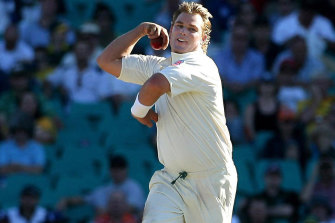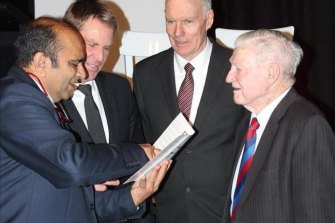How I’d have faced Warnie, the conjurer: Greg Chappell’s tribute to his friend
When I think of Shane Warne, I think of the words of American naturalist, poet and writer Henry David Thoreau: “It’s not what you look at, it is what you see.” Shane Warne was an illusionist first and a great leg-spin bowler second.
I was fortunate to get to know Shane well in his post-cricket days by playing numerous games of golf with him at one of his favourite courses, Cathedral Lodge and Golf Club in Thornton, Victoria. You get to know someone pretty well when you spend four hours with them on the golf course and then as many again over post-round replays.
Shane Warne’s bowling action at the fifth Test at the SCG, 2007.Credit:PA
What you got with Shane wasn’t necessarily what you saw. You only got what he let you see. Most people’s impressions of him were coloured by what they gleaned from the way he was depicted in the media. That, often, only touched the surface.
Shane was the quintessential competitor. He loved games and he loved to pit himself against an opponent where he could utilise his mental acuity and his enormously strong self-belief. I have often experienced his uncanny ability to will the magical to happen.
He had so much belief in his superpowers that he was usually staggered when it didn’t come off. It was invariably written off to extreme bad luck. Some of his golf opponents tried to use this against him by telling him how unlucky he was, but it is hard to kid a kidder.
Chappell Foundation chair Darshak Mehta, Shane Warne, Greg Chappell and Test great Neil Harvey at a Chappell Foundation fundraiser.
During our chats on the golf course, Shane was always eager to talk about his three children, Brooke, Jackson and Summer. He was kind, caring and, above all else, a doting father. His many acts of kindness to others were only known to those closest to him.
I was always interested in his attraction to poker, which he played regularly. Because I was never much interested in cards, I asked him how his attraction began. He said it started early in his life and he found, because of his ability with numbers and numerical patterns, that it came naturally to him. It also suited his competitive nature and his ability and delight in messing with opponents’ minds.
When I asked him about his method at the poker table, he delighted in telling me how, when he was in a new group, he would bounce around a bit in the first few rounds to give the impression that he was new to the game. He would make sure he didn’t lose too much in those rounds, but used this time to sum up his opponents; then he wouldn’t worry too much about the odds, he would just play the man and clean up.
Much as he did on the cricket field. Watching Warnie bowl was like watching an enactment of the Oberammergau Passion Play. Everything was finely tuned, elaborately planned and played out to a tried and tested script. Ian Healy and the close fielders were important characters, but for Warnie, it was as much about the theatrics as it was about the art of spin bowling. He was a conjurer as much as a spin bowler. In his early days, he spun the ball as hard as anyone had. Those who batted against him said the ball seemed to have a life of its own as it hummed towards them, dipped and then spun crazily from the pitch.
His sturdy body and big, meaty hands were another important part of what made him the bowler he was. This, allied with a grip that was lower in the fingers, into the palm of the hand, was very different to the traditional leg spinners of previous generations, who held the ball more towards the end of the fingers. His grip and strong shoulder action, with a full follow-through, literally made the ball buzz.
During his career, I had the pleasure of commentating on a series in England and watched up-close while Warnie gave a master-class for the broadcasters before the start of play one morning at Edgbaston. I took the chance to grab a stump and stand in the batsman’s position to give him a reference point. It was fantastic to see the ball coming towards me before dipping to the leg side and spinning viciously from one of the side wickets. While I was there, I was formulating a plan in my mind of how I would have batted against him.
As a right-hander, I would not have wanted him to get behind my legs, which is a blind-spot (just ask Mike Gatting!) so I decided I would most likely have adopted a more front-on stance than the traditional side-on method, so I could keep the ball in view as much as possible. This would have had the other effect of putting his fielders out of position because I would then hit the ball straighter than his normal positions would account for.
I also would have wanted to take Warnie out of the picture and focus on the ball leaving his hand rather than him and his mind games. I have no doubt that he sucked many batsmen into his web of theatrics and they forgot to watch the ball. South Africa’s Daryll Cullinan was one who could not separate the two and fell constantly to his flipper. I wonder if his nightmares will stop now that Warnie has gone!
The others who were susceptible to his mind games were the umpires. Warnie would play the less experienced of them like an old fiddle with steel core strings and suck them into his web in the hope of encouraging them to give more lbws.
Shane was more than just a leg spinner. He was an entertainer with enormous charisma who attracted attention wherever he went. His success generated millions of viewers to the game and brought the art of leg spin to life. It also spawned a new generation of leg spinners who tried to walk up to the crease and let it rip! What they didn’t have was Shane’s brute strength and native cunning, so very few have reached great heights.
Bradman is unrivalled as the best batsman Australia has produced, Shane would be runaway best spinner, Keith Miller is unmatched as the best all-rounder, Jeff Thomson, the quickest fast bowler and Dennis Lillee the best fast bowler.
No one has had a bigger impact on the game since World War II than Shane, who managed to combine a flamboyant private life with a legendary, storied cricket career.
Once you got to know him, what you saw was what you got. He was unfailingly generous with his time with all and sparkling company. Determined to live his life his way, he genuinely didn’t worry what others thought of him. He was true to himself and very loyal to those close to him.
His impact reached every corner of the cricket world and beyond. Tributes are coming in from all points, which indicates the respect in which he was held by fan and foe alike. We will never see the like of him again, nor anyone even close.
RIP Shane.
The Morning Edition newsletter is our guide to the day’s most important and interesting stories, analysis and insights. Sign up here.
Most Viewed in Sport
From our partners
Source: Read Full Article


